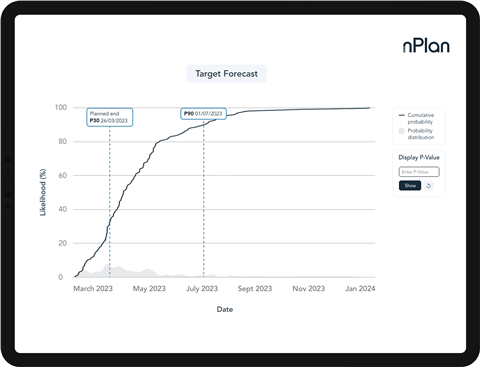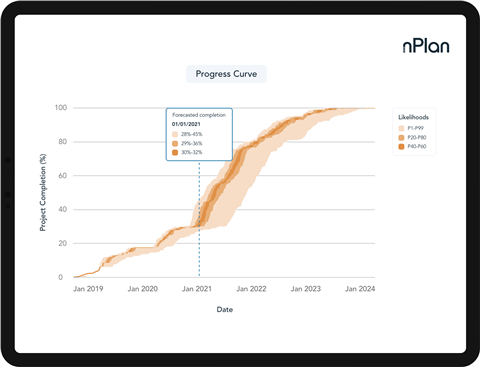Can machine learning help mend the contracting system?
19 January 2022
Dev Amratia, chief executive of tech start-up nPlan is using machine learning to help estimate accurate construction timetables. He tells Lucy Barnard how new technology could work to fix the broken contracting system.
“Contracting for construction projects is just a crappy business to be in,” says Dev Amratia, the co-founder of computer learning construction tech start-up nPlan.
Despite his attempts to keep as quiet as possible in order not to wake his five-month-old daughter sleeping at his feet during our interview, Amratia, can’t help waving his hands for emphasis as he explains why the contracting system is broken.
“It’s almost impossible for a mainstream contractor to have a competitive advantage over another contractor,” he says via a Teams interview. “It’s very hard to say that Kier is better than Balfour Beatty or Amey or any of the others – or will do a better job. They know that. And that is why the price margin in construction is so low. In any market when you have very low competition differentiators you cannot create a price advantage.”
 nPlan founders Dev Amratia and Alan Mosca
nPlan founders Dev Amratia and Alan Mosca
Amratia formed his opinions about the contracting sector earlier in his career while working as a project manager on an 11.4m tonne-producing oil and gas plant on Russia’s Sakhlin Island for energy giant Shell.
At the time, he says, his team would have been willing to pay a 30% premium to any contracting firm willing to guarantee that construction would be completed on time and on budget.
“We were willing to pay a 30% profit margin which is unheard of in the construction industry – but no-one was willing to do it,” he says.
“If someone can tell me when that refinery is going to start, I can plan when the crude oil will arrive, I can plan all my offtake agreements, I can guarantee to my customers when they are going to get refined products. So much money is sitting on that guarantee ability which is fundamentally broken in the construction industry because no contractor can do it.”
Certainly, failing to meet budgets and deadlines is a perennial problem in the construction industry, from small players misquoting on domestic work to massive projects overrunning (sometimes by years, or decades) and often ending in lengthy legal battles.
According to Arcadis’ construction disputes team, the average value of the legal battles between contractors and clients around the world in 2021 stood at US$54.26 million, while the average length of disputes was 13.4 months.
Why do construction projects run late?
Big construction firms are often criticised for quoting unrealistically low prices for projects in order to win work and then putting pressure on suppliers to sell services and materials at similarly low prices so that they can still turn a profit. The practice can encourage construction teams to cut corners, leading to poorer quality work and less safe practices on site.
Amratia argues that one of the reasons that contractors end up vastly under-cutting each other and under-estimating in terms of time and money is that they rely on project managers or teams of advisors to estimate how long it will take to complete a job based on previous experience. And, he says, these teams invariably make the all-too-human error of being too optimistic in their assessments.
“Time and time again we see forecasts marked by optimism bias, and risk management skewed by availability bias,” he says.
Instead, Amratia’s solution has been to collaborate with friend and computer engineer Alan Mosca to create a computer programme which uses machine learning to analyse datasets from previous projects to remove human bias from the entire process and come up with, what he says, is a more accurate and sensible prediction.
“The firms which say that they will do it cheaper and faster on day one, are also the firms that will screw you and delay the project halfway through and make claims saying that it’s not our fault it’s your fault – and basically the asset in the end gets delivered very late,” he says.
“nPlan’s value proposition is to act as an independent arbitrator of the truth. So, contractors can tell clients, don’t take our word for it, but we are using this technology which has analysed all this past data and it’s saying this, and our bid is based on that, it’s not based on some rose-coloured glasses of what we hope this project might one day become,” Amratia says.
“An increasing number of clients appreciate that because they can calculate the economic value of that. And it’s better for the contractor because they are not in a race to the bottom like the rest.”
 nPlan’s computer model predicts likely completion times
nPlan’s computer model predicts likely completion times
Using data in construction
So how does nPlan do it? Firstly, the company has persuaded its major construction clients in eight different countries, including Deutsche Bahn, Network Rail, Shell, Kier and Google, to share years of Gantt charts and other data detailing both predictions for various individual elements of construction projects and also their actual outcomes. Any new clients must also share past data before they are taken on.
nPlan then uses a machine learning algorithm on the amassed data to produce a tool which can break down new projects into each of their many component parts. These include; how many concrete pours will take place as part of the construction, or how much electric cabling will be laid and in what order. The computer then assesses each task in detail and analyses it in comparison with the past data to produce an informed prediction for how long the entire project will take.
“We don’t care about the project,” Amratia says. “The project is just a collection of activities. We are working right down in the gory details.
“Our thesis is that we don’t think a human being can do this kind of work. It’s just too complex. So let’s get a machine to do this kind of work for us. Human beings don’t love playing at that level, right? But machines are quite good at doing tedious tasks at that activity level, trying to determine patterns and trying to produce forecasts per activity. Then you roll that up to the project level.”
But how can you ever find one concrete pour which exactly matches the concrete pour being planned? Amratia argues that, in fact, in you have enough data from all past concrete pours then you don’t have to.
How machine learning analyses construction data
Instead of attempting to find a perfect match for each activity using computer learning, the programme will trawl through hundreds of thousands of data points, assessing them all.
“Step one is to try and understand the context of those concrete pours in mathematical terms. These are not the sort of context you or I might look for, like what is the weather going to be, which city or country are you doing it in, who is the contractor that is going to do the work. Machines don’t understand that,” Amratia says.

Then the model uses machine learning to inform its predictions, giving greater weight to past activities which it considers most similar and heavily discounting ones which it considers less similar. Eventually it can create a probability distribution curve for how long it thinks each activity will take, based on past information.
“It tries to generate context by inference,” Amratia adds. “So, it will look at the surrounding activities to try and figure out what might this look like in relative sense to all the other concrete pours it has ever seen. And where it can draw conclusions like, this mathematically looks similar to this other concrete pour and different from this other concrete pour, then we’ve got the ability for the data in the past to come forward and inform that activity that needs to be forecasted. It will look at how each of those concrete pours performed. So, did you plan them for six days and they actually took 20 days? And it will bring that information forward.”
The model’s ability to analyse huge swathes of data doesn’t end there. Other data, seemingly unrelated to each specific activity, can also inform the outcome.
How is machine learning used in construction?
“It’s not an on/off switch, it’s relative,” Amratia adds. “Everything is a sliding scale. It will even use data that has nothing to do with a concrete pour like installing electrical cables... it’s an example of a pattern that is non-intuitive to a human being but through sufficient volumes of data the algorithm is able to detect such patterns and bring that forward into the forecast.”
But how does it know to do all that? Amratia laughs. “How does it know is the most common question we get,” he says. “It’s never explicitly written into the scheduled file itself. The way it does it is through pattern recognition through scale. If you were a seasoned planner and I put two schedule files on the table and hid the name of the project at the top and said which one is a bridge and which is a house most people would get it. You can make it harder and find out which is bigger or built using a contract which had a unionised workforce.
“As these questions start becoming harder and harder, the planner will start to use their pattern recognition that they have seen in the past to say, ‘I’m 70% sure that this one is unionised labour’. When you ask why, the answer you will get is that it just feels that way. I’ve seen lots of unionised labour projects and the way this one is structured is that it feels like one of those ones. What they are actually saying is that my brain is recognising a pattern in the data I’m analysing in front of me that is correlated to the specific events I’ve seen in the past. So, copy that and apply it to a machine and it’s the same process.”
Eventually, when it has completed its analysis, nPlan provides its clients with a chart in the form of a distribution curve, predicting when it believes the construction is likely to complete within certain parameters. How big those parameters are depends on the project and how much historical data there is to compare it to.
For a fairly standard office block with a three-year construction programme, nPlan says the variance is likely to be around four months. But, for a one-off project never attempted before and without historical precedence, the variance on a planned 15-year project could well be 15 years.
 The model produces a probability distribution curve to give likely outcomes
The model produces a probability distribution curve to give likely outcomes
Amratia says that the company knows that its predictions are right because it frequently tests itself, going back to analyse previous projects and predicting them as if they have yet to happen to see if they can get it right.
However, this only really holds true for many of the recent schemes the company has analysed – certainly many of those taking place during the pandemic – if you include the huge range of variance included in its charts.
“One thing we have in our favour is that we never produce a single point estimate in time,” Amratia says. “When I say we can predict the time to complete a London office block within three to four months, you have to remember that everything we produce is a probability distribution function which means the functional tail could be five years long – it’s just that there’s a less than five percent chance that you’ll end up in that very long tail.
“So, when you say, what is the variance for an office block, and I say, four months, what I’m reporting to you is that the P5 to P95. I purposefully chop off tails otherwise everything will sound like your variance is huge. This means that the pandemic belongs in the black swan territory but is technically in forecasting range.”
Certainly, nPlan’s data shows that construction delays have doubled since the pandemic began with the median delay for projects completed before the pandemic standing at approximately 100 days, while pandemic-era projects have a median delay of more than 200 days.
Construction and Covid-19
“The pandemic is not the first time specific black swans have occurred on construction projects,” Amratia says. “On the US$11 billion construction project I used to manage on Sakhalin Island in Russia, there was only one road you could use to access it. Now, 600 km away from our facility, a bridge collapsed [making the road unusable]. There was no other way anything could arrive on our facility. And we were like, call the Russian government, could you please fix that bridge because we’re screwed. And they were like, not our problem. And we were like, ok. We didn’t see that coming.”
“And it caused an enormous delay to our project,” he adds. “In construction project managers words, ‘shit happens’. That has been systemic across this industry forever, right? We can’t foresee this stuff happening but it happens all the time. The only difference here is that during the pandemic the shit happened to everyone at the same time.”
STAY CONNECTED



Receive the information you need when you need it through our world-leading magazines, newsletters and daily briefings.
CONNECT WITH THE TEAM









